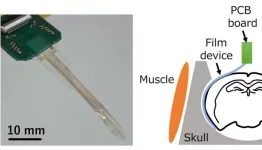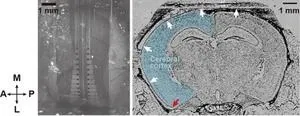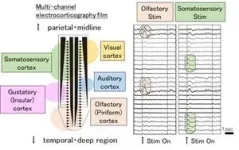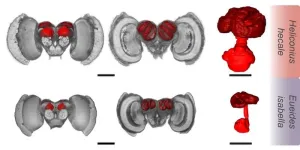Associate Professor Hiroto Sekiguchi (Department of Electrical and Electronic Information Engineering, Toyohashi University of Technology) and Assistant Professor Susumu Setogawa and Associate Professor Noriaki Ohkawa (Comprehensive Research Facilities for Advanced Medical Science, Dokkyo Medical University; Assistant Professor Setogawa is currently a Specially Appointed Assistant Professor at University Public Corporation Osaka) have developed a flexible electrocorticography (Note 1) film for simultaneous detection of multisensory information (Note 2) from multiple regions of the cerebral cortex by placing neural electrodes over a wide area of a mouse brain surface.
Researchers believe that the human brain achieves cognitive functions such as attention, learning, and memory through the simultaneous processing and integration of various sensory information across multiple regions of the cortex. In order to understand the neural information processing mechanisms underlying these cognitive functions, researchers required a device capable of simultaneous recording neural activity from a wide area of the cerebral cortex, including the temporal region responsible for processing diverse sensory information in rodents such as mice and rats. However, the placement of such a device posed challenges due to the obstruction of the temporal region in a rodent’s head caused by the skull and surrounding temporal muscles.
Therefore, in order to successfully position an electrocorticogram recording device in the temporal and deep regions of the cerebral cortex of mice, it was crucial to develop a device and establish a technique which allows recording electrodes to be placed in the narrow gap between the skull and the surface of the cerebral cortex. Our research group achieved two significant advancements, (1) development of a cortical electrocorticography device composed of an appropriate film that exhibits both flexibility and rigidity for attached to the brain, and (2) establishment of a surgical technique for effectively attaching the device to the temporal region of the brain. As a result, these advancements allow to successfully detect neural activity in the cerebral cortex that was evoked by somatosensory and olfactory stimuli. This novel electrocorticography device has achieved a wider range of neural activity measurements compared to existing techniques. Moving forward, the method is anticipated to contribute to advancing research on large-scale electrocorticography, facilitating a better understanding of the functional interaction among different brain regions and their mechanism.
The results of this research were published online in the scientific journal Molecular Brain on May 3, 2023. This research was performed through support from Japan Science and Technology Agency (JST) Strategic Basic Research Promotion Project PRESTO (JPMJPR1885)), the Casio Science Promotion Foundation, the Toyoaki Scholarship Foundation, the Foundation of Public Interest of Tatematsu, the Research Foundation for Opto-Science and Technology, the Takeda Science Foundation, the Naito Foundation, the Astellas Foundation for Research on Metabolic Disorders, and the Tochigi Industrial Promotion Center (the Grant-in-Aid for World-Class Technological Research and Development).
Details
There has been a growing number of patients such as dementia, schizophrenia, and developmental disorders. One contributing factor to these diseases is the impaired cognitive function due to failure of information integration systems in the brain. However, the precise mechanisms by which the brain integrates information from diverse sensory information obtained from various environments are still not fully understood. In order to deepen our understanding of these information integration systems, it is necessary to develop biometric techniques to simultaneously monitor the activities of multiple brain regions distributed across the cerebral cortex, governing diverse sensory information. Neuroscience research utilizing advanced tools is being conducted on rodents such as mice and rats to investigate the neural circuit mechanisms underlying cognitive functions. Researchers have required a large-scale measurement technology that covers the parietal region to the temporal region of the rodent cerebral cortex. However, the conventional microscope-based large-scale calcium imaging (Note 3) and electrophysiological techniques (Note 4) for measurement of brain activity in rodents have been limited to the parietal area of the rodent head due to the hindrance caused by the thick skull and surrounding temporal muscles. Therefore, researchers needed to develop a novel device that can simultaneously detect a wide range of multisensory information from the cerebral cortex including the temporal region, and to establish technology for placement of that device.
With the goal of developing a multi-channel electrocorticography device that can cover a wide area of the brain, this research group proposed the concept of inserting an electrocorticogram measurement device into the narrow gap between the mouse skull and the dura mater. In order to achieve this, the device needed to have both flexibility and rigidity to enable adherence to the brain surface. The research group addressed this requirement by selecting the appropriate width and thickness of the parylene film (Note 5), which serves as the base of the device, and by establishing a surgical technique for placing the film in the temporal region. As a result, the research group successfully positioned multi-channel electrodes across a wide area extending from the somatosensory cortex to the deepest part of the cerebral cortex, known as olfactory cortex. Furthermore, by using an electrocorticography device equipped with 64-channel recording electrodes, the group achieved electrocorticogram measurement from a wide area of the cerebral cortex of awake and anesthetized mice. The research group also confirmed that the developed device, along with its placement technique, can detect neural responses evoked by both somatosensory and olfactory stimuli in the same mouse, thereby enabling simultaneous detection of widely distributed multisensory information in the brain.
Future Outlook
The developed multi-channel electrocorticography device technology holds great potential for application across a wide range of mouse brains. This is a novel measurement technology that expands the scope of electrocorticogram recording in the rodent cerebral cortex beyond the previous limitation. Until now, electrocorticogram measurement from the cortical surface of the temporal region was limited to humans and monkeys. However, this innovative technology will enable electrocorticogram measurement even in mice across a wide range from the parietal region to the temporal region. Through genetic engineering technology, transgenic animals of valuable disease models for various human conditions have been established. By utilizing the measurement technology developed in this research, it will allow to compare human cases with the research finding obtained from disease model animals. Advancing their understanding of the brain mechanism responsible for integrating diverse information in rodents will facilitate the elucidation of the pathological mechanisms underlying human neurological and psychiatric disorders, thereby developing new therapeutic techniques.
Reference
Susumu Setogawa, Ryota Kanda, Shuto Tada, Takuya Hikima, Yoshito Saitoh, Mikiko Ishikawa, Satoshi Nakada, Fumiko Seki, Keigo Hikishima, Hideyuki Matsumoto, Kenji Mizuseki, Osamu Fukayama, Makoto Osanai, Hiroto Sekiguchi, Noriaki Ohkawa, “A novel micro-ECoG recording method for recording multisensory neural activity from the parietal to temporal cortices in mice”, Molecular Brain, 16, Article number:38(2023)
DOI:10.1186/s13041-023-01019-9.
Explanation of Terms
Note 1: Electrocorticography
A method of measuring neural activity in which the skull is surgically removed and a sheet with multiple electrodes is placed on the surface of the brain in order to electrically measure the activity of the cerebral cortex.
Note 2: Multisensory information
Refers to multiple senses such as somatosensory (touch), visual, olfactory, auditory, and gustatory. The human brain perceives phenomena by combining these multiple senses.
Note 3: Calcium imaging (method)
A method of obtaining spatiotemporal information of neural activity in the format of image information by using indicator dyes and proteins that bind with calcium ions and emit fluorescence in order to convert neural cell activity into fluorescence.
Note 4: Electrophysiological technique
A method of recording electrical information (potential/current) of cells by placing glass or metal electrodes on neural cells. Examples include electroencephalograms, electrocardiograms, and electromyograms.
Note 5: Parylene film
A general term for paraxylylene-based polymers. Known as a biocompatible material. An extremely thin film can be formed using vapor deposition. Parylene film can be used as a coating material for biomedical devices such as pacemakers.
END








